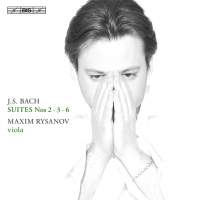Texte paru dans: / Appeared in:
*

International Record Review - (06//2014)
Pour
s'abonner / Subscription information
BIS
BIS2033

Code-barres / Barcode : 7318599920337
(ID418)
This release brings Maxim Rysanov's persuasive survey of the six Bach Cello Suites transcribed for viola to completion. The first volume (BIS1783SACD) marked the Ukrainian's debut recording for the label, encompassing Suites Nos. 1, 4, and 5, and those who heard it will already have a clear idea of what to expect from this follow‑up. For those new to Rysanov's playing style, however, these sharply etched, punchy realizations should immediately impress for their power and vitality, though quite a few boxes will remain un‑ticked if you prefer to hear historically informed performances of the Bach suites.
There are long‑ established precedents for playing the Six Cello Suites, BWV1007‑12 on the viola, though what instantly distinguishes Rysanov's cycle from most of its rivals is that it reaches an especially daring and, by any reckoning, a truly remarkable conclusion, the reasons for which should be understood by anyone who might be contemplating purchasing this new disc. 'I like breaking my own rules and setting myself impossible challenges', Rysanov explained in a recent article (reproduced in part in the booklet notes here), and the seemingly insuperable obstacles posed by his decision to perform BWV1012 in its original key of D major (rather than a fifth lower in G, as is normal on the viola) were, he says, trials he had to overcome, or die trying!
Most violists, by the way, still play the work a fifth lower in G, traditionally excusing themselves on the grounds that even the great William Primrose considered it otherwise totally impractical. Played in D major, much of the Sixth Suite sits at the high extremes of the viola's compass, requiring the player to remove the left thumb from behind the neck (where it also aids in supporting the weight of the instrument) and allowing it to slide up and down the fingerboard, though it never becomes an extra 'finger' as it does in cello thumb‑position. The technique is both perilous and daunting for the player, though Rysanov meets every dangerous moment of the Sixth Suite headlong, with phenomenal bravura and stamina, in a performance which can only be described as a technical tour de force.
Still, as Gérard Caussé reminded us in an introductory note for his own recording of the suites, Bach himself was a viola player, and that he was unaware of the transferability of these works to other instruments seems faintly inconceivable. But whereas Caussé's traversal was the outcome of many years of study, reflection and reworking of earlier notions about how this music should be approached, Rysanov's is attended by a devil-may‑care spontaneity which is undeniably exciting, provided purist notions of how this music ought to be played can be temporarily set aside.
Certainly there can never be a truly consensual approach to Bach performance and while Ryganov's cycle is always impeccably played it probably won't appeal to traditionalists. His style is modernistic and personal. Indeed he never claims otherwise, explaining that 'the idea was to create an impression of something cosmic, something global. That's quite different from, say, a current "historically‑informed" style. I don't belong to either school. I can't call myself a Baroque specialist and I don't play Bach in the way I was taught in Russia: instead, I've developed my own approach from many influences.'
Vibrato is used quite sparingly, though one is less readily drawn into the intimacy of the musical dialogue, which was one of the winning attributes of Caussé's playing. And whereas Caussé took fairly measured, even stately tempos in some of the livelier dances (such as Minuets I and II in Suite 1, the Bourrée of the C major work and closing Gigue of the E flat Suite), Rysanov, like Nobuko Imai in her superb Philips recordings, is more boisterously athletic with them. Neither is as good as Caussé in the more expressive Allemande and Sarabande movements, where courtly gesture often gives place to gravitas. Rysanov excites for different but no less valid reasons, and his astounding performance of the Sixth Suite is a remarkable achievement.
The BIS SACD recording is
brightly lit and somewhat clinical but never overresonant, capturing the
timbre and tonal heft of Rysanov's Guadagnini instrument with uncanny
realism.
Fermer la fenêtre/Close window
Cliquez l'un ou l'autre
bouton pour découvrir bien d'autres critiques de CD
Click either button for many other reviews


